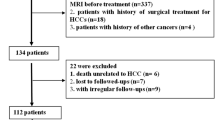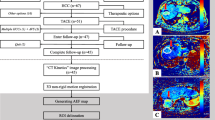Abstract
Aim
To investigate a pre-therapeutic radiomics nomogram to accurately predict hepatocellular carcinoma (HCC) lesion responses to transcatheter arterial chemoembolization (TACE).
Methods
This retrospective study from January 2012 to 2022 included 92 TACE-treated patients who underwent liver contrast-enhanced CT scan 7 days before treatment, having complete clinical information. We extracted quantitative texture parameters and clinical factors for the largest tumors on the baseline arterial and portal venous phase CT images. An adaptive least absolute shrinkage and selection operator (LASSO)-penalized logistic regression identified independent predictors of tumor activity after TACE.
Results
We fitted an adaptive LASSO regression model to narrow down the texture features and clinical risk factors of the tumor activity status. The selected texture features were used to construct radiomic scores (RadScore), which demonstrated superior performance in predicting tumor activity on both the training (area under the curve (AUC): 0.881, 95% CI: 0.799–0.963) and testing sets (AUC: 0.88, 95% CI: 0.726–1). A logistic regression-based nomogram was developed using RadScore and four selected clinical features. In the testing set, nomogram total points were significant predictors (P = 0.034), and the training set showed no departure from perfect fit (P = 0.833). Internal validation of the nomogram was obtained for the training (AUC: 0.91, 95% CI: 0.837–0.984) and testing (AUC: 0.889, 95% CI: 0.746–1) sets.
Conclusion
We propose a nomogram to predict the early response of HCC lesions to TACE treatment with high accuracy, which may serve as an additional criterion in multidisciplinary decision-making treatment.
Graphical Abstract





Similar content being viewed by others
Data availability
The raw data generated in this study are available in the article and its supplementary data files. Derived data supporting the findings of this study are available from the corresponding author upon reasonable request.
References
Villanueva A. Hepatocellular Carcinoma. N Engl J Med 2019; 380(15): 1450-62.
Department of Medical Administration NH, China HCotPsRo. Guidelines for diagnosis and treatment of primary liver cancer in China (2019 edition). Zhonghua Gan Zang Bing Za Zhi 2020; 28(2): 112-28.
Heimbach JK, Kulik LM, Finn RS et al. AASLD guidelines for the treatment of hepatocellular carcinoma. Hepatology 2018; 67(1): 358-80.
Wang Q, **a D, Bai W et al. Development of a prognostic score for recommended TACE candidates with hepatocellular carcinoma: A multicentre observational study. J Hepatol 2019; 70(5): 893-903.
Llovet JM, Real MI, Montana X et al. Arterial embolisation or chemoembolisation versus symptomatic treatment in patients with unresectable hepatocellular carcinoma: a randomised controlled trial. Lancet 2002; 359(9319): 1734-9.
Bargellini I, Sacco R, Bozzi E et al. Transarterial chemoembolization in very early and early-stage hepatocellular carcinoma patients excluded from curative treatment: a prospective cohort study. Eur J Radiol 2012; 81(6): 1173-8.
Aerts HJ, Velazquez ER, Leijenaar RT et al. Decoding tumour phenotype by noninvasive imaging using a quantitative radiomics approach. Nature communications 2014; 5(1): 1-9.
Gillies RJ, Kinahan PE, Hricak H. Radiomics: images are more than pictures, they are data. Radiology 2016; 278(2): 563.
Brenet Defour L, Mulé S, Tenenhaus A et al. Hepatocellular carcinoma: CT texture analysis as a predictor of survival after surgical resection. European Radiology 2019; 29(3): 1231-9.
Kong C, Zhao Z, Chen W et al. Prediction of tumor response via a pretreatment MRI radiomics-based nomogram in HCC treated with TACE. European radiology 2021; 31(10): 7500-11.
Zhou Y, He L, Huang Y et al. CT-based radiomics signature: a potential biomarker for preoperative prediction of early recurrence in hepatocellular carcinoma. Abdom Radiol (NY) 2017; 42(6): 1695-704.
Elsayes KM, Hooker JC, Agrons MM et al. 2017 Version of LI-RADS for CT and MR Imaging: An Update. Radiographics 2017; 37(7): 1994-2017.
Kielar A, Fowler KJ, Lewis S et al. Locoregional therapies for hepatocellular carcinoma and the new LI-RADS treatment response algorithm. Abdom Radiol (NY) 2018; 43(1): 218-30.
Zheng XH, Guan YS, Zhou XP et al. Detection of hypervascular hepatocellular carcinoma: Comparison of multi-detector CT with digital subtraction angiography and Lipiodol CT. World J Gastroenterol 2005; 11(2): 200-3.
Kim J, Choi SJ, Lee S-H, Lee HY, Park H. Predicting survival using pretreatment CT for patients with hepatocellular carcinoma treated with transarterial chemoembolization: comparison of models using radiomics. American Journal of Roentgenology 2018; 211(5): 1026-34.
Raoul JL, Forner A, Bolondi L, Cheung TT, Kloeckner R, de Baere T. Updated use of TACE for hepatocellular carcinoma treatment: How and when to use it based on clinical evidence. Cancer Treat Rev 2019; 72: 28-36.
Miles KA, Ganeshan B, Hayball MP. CT texture analysis using the filtration-histogram method: what do the measurements mean? Cancer Imaging 2013; 13(3): 400.
Lubner MG, Smith AD, Sandrasegaran K, Sahani DV, Pickhardt PJ. CT Texture Analysis: Definitions, Applications, Biologic Correlates, and Challenges. Radiographics 2017; 37(5): 1483-503.
Park HJ, Kim JH, Choi S-y et al. Prediction of therapeutic response of hepatocellular carcinoma to transcatheter arterial chemoembolization based on pretherapeutic dynamic CT and textural findings. American Journal of Roentgenology 2019; 209: W211-W20.
Vosshenrich J, Zech CJ, Heye T et al. Response prediction of hepatocellular carcinoma undergoing transcatheter arterial chemoembolization: Unlocking the potential of CT texture analysis through nested decision tree models. European radiology 2021; 31(6): 4367-76.
Jeong SO, Kim EB, Jeong SW et al. Predictive Factors for Complete Response and Recurrence after Transarterial Chemoembolization in Hepatocellular Carcinoma. Gut Liver 2017; 11(3): 409-16.
Song W, Yu X, Guo D et al. MRI-Based Radiomics: Associations With the Recurrence-Free Survival of Patients With Hepatocellular Carcinoma Treated With Conventional Transcatheter Arterial Chemoembolization. J Magn Reson Imaging 2020; 52(2): 461-73.
Durazo FA, Blatt LM, Corey WG et al. Des-gamma-carboxyprothrombin, alpha-fetoprotein and AFP-L3 in patients with chronic hepatitis, cirrhosis and hepatocellular carcinoma. J Gastroenterol Hepatol 2008; 23(10): 1541-8.
Di Bisceglie AM, Hoofnagle JH. Elevations in serum alpha-fetoprotein levels in patients with chronic hepatitis B. Cancer 1989; 64(10): 2117-20.
Tseng TC, Liu CJ, Yang HC et al. High levels of hepatitis B surface antigen increase risk of hepatocellular carcinoma in patients with low HBV load. Gastroenterology 2012; 142(5): 1140-9 e3; quiz e13-4.
Chien J, Liu J, Lee MH et al. Risk and predictors of hepatocellular carcinoma for chronic hepatitis B patients with newly developed cirrhosis. J Gastroenterol Hepatol 2016; 31(12): 1971-7.
Kan Z. Dynamic study of iodized oil in the liver and blood supply to hepatic tumors. An experimental investigation in several animal species. Acta Radiologica Supplementum 1996; 408: 1-25.
Miyayama S, Matsui O, Taki K et al. Extrahepatic blood supply to hepatocellular carcinoma: angiographic demonstration and transcatheter arterial chemoembolization. Cardiovasc Intervent Radiol 2006; 29(1): 39-48.
Moustafa AS, Abdel Aal AK, Ertel N, Saad N, DuBay D, Saddekni S. Chemoembolization of Hepatocellular Carcinoma with Extrahepatic Collateral Blood Supply: Anatomic and Technical Considerations. Radiographics 2017; 37(3): 963-77.
Mathupala SP, Rempel A, Pedersen PL. Glucose catabolism in cancer cells: identification and characterization of a marked activation response of the type II hexokinase gene to hypoxic conditions. J Biol Chem 2001; 276(46): 43407-12.
Lee HS, Kim JS, Choi IJ, Chung JW, Park JH, Kim CY. The safety and efficacy of transcatheter arterial chemoembolization in the treatment of patients with hepatocellular carcinoma and main portal vein obstruction. A prospective controlled study. Cancer 1997; 79(11): 2087-94.
Georgiades CS, Hong K, D'Angelo M, Geschwind JF. Safety and efficacy of transarterial chemoembolization in patients with unresectable hepatocellular carcinoma and portal vein thrombosis. J Vasc Interv Radiol 2005; 16(12): 1653-9.
Chung GE, Lee J-H, Kim HY et al. Transarterial chemoembolization can be safely performed in patients with hepatocellular carcinoma invading the main portal vein and may improve the overall survival. Radiology 2011; 258(2): 627-34.
Nezami N, JMM VANB, Konstantinidis M et al. Lipiodol Deposition and Washout in Primary and Metastatic Liver Tumors After Chemoembolization. In Vivo 2021; 35(6): 3261-70.
Chen L, Yang R, Zhu L, Zhu X. Imaging characteristics and intervention therapy for hepatic artery-portal vein shunts in patients with primary liver carcinoma. Chinese Journal of Clinical Oncology 2015; 24(8): 570–5.
Sun L, Shi H, Liu S. The factors related to the formation of arterioportal shunting in patients with hepatocellular carcinomas. Journal of Interventional Radiology 2012; 21(3): 206-10.
Do RK, Mendiratta-Lala M. LI-RADS Version 2018 treatment response algorithm: the evidence is accumulating. Radiology 2018; 294(2): 327-8.
Abdel Razek AAK, El-Serougy LG, Saleh GA, Shabana W, Abd El-Wahab R. Reproducibility of LI-RADS treatment response algorithm for hepatocellular carcinoma after locoregional therapy. Diagn Interv Imaging 2020; 101(9): 547-53.
Shropshire EL, Chaudhry M, Miller CM et al. LI-RADS Treatment Response Algorithm: Performance and Diagnostic Accuracy. Radiology 2019; 292(1): 226-34.
Acknowledgements
This work was supported by the Cancer Interventional Research Fund [NO. XM_2018_011_0006_01 and HRIRF-2019-C003] (B.H), the Fund of Health and Family Planning Commission of Jiangsu [No. ZD2021059] (B.H), the fifth round of the “Program 333” of Jiangsu [No. BRA2020198] (B.H), the Young Medical Talents Fund of Health and Family Planning Commission of Nantong (No. QA2020002) (B.H), the National Natural Science Foundation of China [No.81973145, No. 82273735] (F.Y.), and Key R&D Program of Jiangsu Province (Social Development) (BE2020694) (F.Y.).
Author information
Authors and Affiliations
Contributions
Conceptualization: XF and BH, Methodology: XF, YW, FY, and BH, Software: XF and YW, Formal analysis: XF and YW, Investigation XF, YC, BC, JC, XS, and JY, Writing of the original draft: XF and YW, Funding acquisition: FY and BH, Supervision: BH.
Corresponding author
Ethics declarations
Conflict of interest
The authors declare no potential conflicts of interest.
Additional information
Publisher's Note
Springer Nature remains neutral with regard to jurisdictional claims in published maps and institutional affiliations.
Supplementary Information
Below is the link to the electronic supplementary material.
Rights and permissions
Springer Nature or its licensor (e.g. a society or other partner) holds exclusive rights to this article under a publishing agreement with the author(s) or other rightsholder(s); author self-archiving of the accepted manuscript version of this article is solely governed by the terms of such publishing agreement and applicable law.
About this article
Cite this article
Fan, X.L., Wang, Y.H., Chen, Y.H. et al. Computed tomography texture analysis combined with preoperative clinical factors serve as a predictor of early efficacy of transcatheter arterial chemoembolization in hepatocellular carcinoma. Abdom Radiol 48, 2008–2018 (2023). https://doi.org/10.1007/s00261-023-03868-3
Received:
Revised:
Accepted:
Published:
Issue Date:
DOI: https://doi.org/10.1007/s00261-023-03868-3




